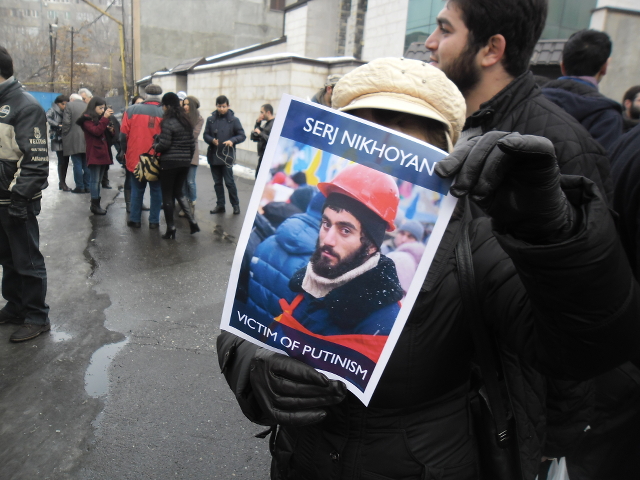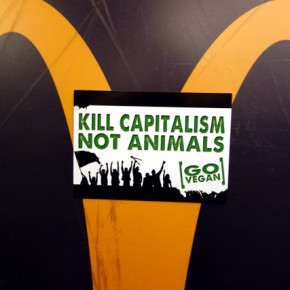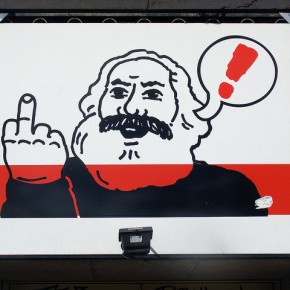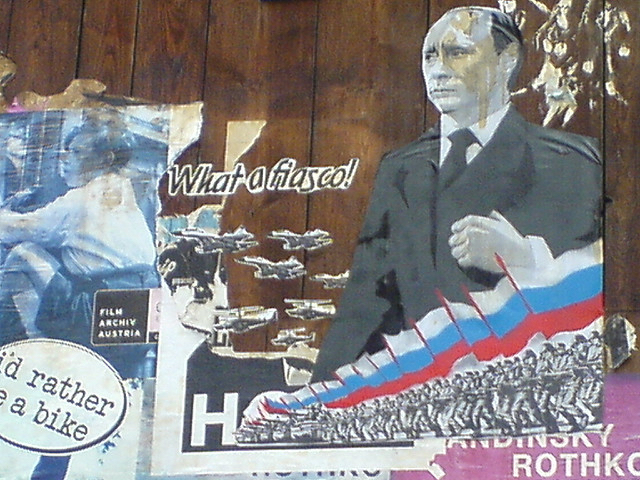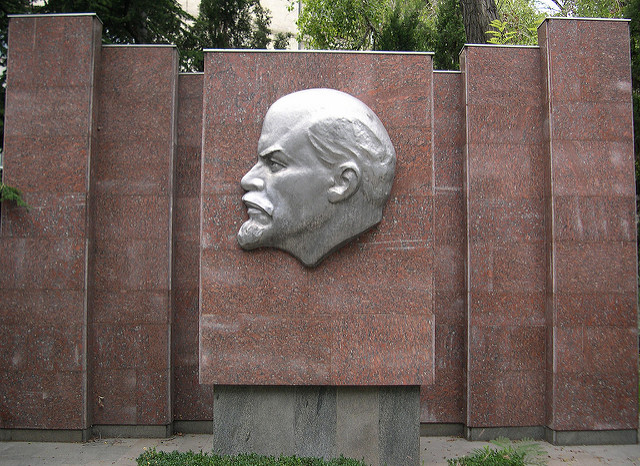There’s been a chilling feeling of déjà vu in Yerevan since the Ukrainian government’s decision to opt out of the EU Association Agreement. Though, as in the Ukraine, many Armenians depend on links to Russia for their livelihood, those who prefer a European course sense that Ukrainian demonstrators are managing to do what Armenians cannot.
On January 22nd, 20 year old Armenian-Ukrainian Serhiy (referred to in Armenia as ‘Serzh’) Nigoyan died from gunshot wounds on Kiev’s Hrushevskoho Street. Ukraine’s Interior Ministry denied responsibility. Born in the Ukraine, from the village of Bereznovativka, near Dniepropetrovsk, Nigoyan was a fluent Ukrainian speaker, and became a symbol of Armenian solidarity with the Euromaidan movement.
In one widely circulated video clip, Serzh was filmed beneath an Armenian flag, reciting a poem by Ukrainian national poet Taras Shevchenko urging the Circassians to liberate themselves from Russian rule. As the first casualty of gunfire in the riots in Kiev, the symbolism of the young Armenian’s death was not lost on Armenians sympathetic to the protesters’ European pretensions. Popular Ukrainian singer Svyatovslav Vakarchuk tweeted that Nigoyan’s “sacrifice for Ukraine” was comparable to the contribution of famous Armenian director Sergei Parajanov, whose 1964 film Shadows of Forgotten Ancestors became a symbol of Ukrainian culture.
On September 3rd 2013, when Armenian President Serzh Sargsyan declared the country’s intention to join the Russian-led Customs Union, many in Yerevan were surprised, if not entirely taken unawares. The guiding strategy of Armenian foreign policy, complementarism, by which the country attempted to balance the interests of competing powers in the South Caucasus region to its own advantage, appeared untenable. “The Armenian government has closed the door to Europe, but that door is not yet locked,” concluded political analyst Richard Giragosian, at a press conference on September 12th.
A key factor is Armenia’s strong military ties to Russia, which maintains a base in the country and patrols its borders with Turkey and Iran. “What would have happened,” Caucasus Institute director Alexander Iskandaryan asked at the same conference, “if our President had said Vladimir-jan, that’s just not possible? […] No Armenian President could have done that. No Serzh Sargsyan or no Sargis Serzhyan. Nobody asked Armenia.” Vladimir Putin’s visit to Armenia in December saw an inspection of the Russian military base at Gyumri, and a range of economic agreements – crucially of all, concerning the energy and transport sectors in Armenia. Yet despite talk about new gas deals, Armenians are still feeling the cold. Protesters in Yerevan called for Sargsyan to reverse his decision and flew Ukrainian flags as they marched through the city centre.

‘Serj Nigoyan: Victim of Putinism’ read flyers outside the Ukrainian Embassy on Davtyan Street in Yerevan on the 24th of January. A low key protest lit candles by the embassy wall in memory of Nigoyan, as well as Yuriy Berbitzkiy and Mihaylo Zhizdnevsky, the latter a native of Belarus. Nigoyan, who had never been to Armenia, was an Armenian patriot, whose vKontakte page, showing him in military fatigues and holding the Armenian flag in a number of locations, was seen as evidence by one (and only one) British blogger that Nigoyan was a “paid mercenary, or an extreme right-wing terrorist, sent to Kiev to fight for the neo-Nazi party Svoboda.” The Ukraine’s Armenian community, meanwhile, was compelled to distance itself from an anonymous online call to avenge Nigoyan’s death.

Ukrainian Ambassador to Armenia Valentin Kuzichkin walked out into the crowd, in order to tell protestors that he, and the Ukrainian Embassy, were not authorised to comment. A few voices raised above the murmuring to shout “Slava Narodu! Slava Ukraini” (Glory to the people! Glory to Ukraine!) but few joined them. This was, after all, a candle-lit vigil. Two student protesters had prepared a French-language banner, half coloured, yet legible with a squint: “L’etat doit obeir le people qui parle.” (The state must obey the people who speak.) “God speaks though the voice of the people,” had read one of Nigoyan’s placards on the Euromaidan.
One protestor, wearing a Nagorno-Karabakh flag, sighed as two Armenian opposition members of parliament cleared their throats and began to address the crowd. “I don’t want this to be too politicised,” he said. Yet the opposition politicians had appeared. “The Ukrainian nation has the right to decide for itself,” declared Paruyr Hayrikian, Soviet dissident and opposition activist shot during his campaign for the Armenian Presidency in January 2013. “Let’s get rid of the USSR – out of the Customs Union,” added the Armenian-language banner behind him.
Davit Shahnazaryan, former Minister of National Security, listened intently, took a minute, a deep breath and then a microphone. “Serj Nikhoyan,” he announced, with a reflective pause after the name “was not the first Armenian victim, but the eleventh killed by Russian imperialism,” in reference and deference to the ten killed in protests during the Armenian Presidential elections of 2008.
The point had been made, and these young post-Soviets furled their banners and, their candles long since extinguished, lit their cigarettes. I stood there, chewing over the events of the past hour, when one eager protester, having listened intently, announced, “I am Western Armenian! Eastern Armenians, like Eastern Ukrainians, want to be with Russia, they are more Soviet!” A few eyebrows ascended. The comparison was an unexpected one.
The police dispersed the demonstrators, and everyone made their way back into the fog of a winter Yerevan. I was left unsure what the recently deceased Serj, Serhiy, or Sergei Nigoyan had meant, and not simply because I don’t speak Armenian. I had lit a candle for him anyway, in what was, I hope, a non-partisan gesture. I’m still a few dozen articles behind on making up my mind, if I ever do.
Taking a tax home, the driver remarked that he had no interest in protesting, or in politics (an Eastern Armenian, our friend would have noted.) He did have a few words of wisdom, as taxi drivers at the end of articles often do.
“I was looking at the Ukrainian flag the other day, and noticed, it would be just like ours, the Armenian one. That is, if you added a strip of blood red above it.”
I can’t say I agree. But we’ll allow him some artistic license. The gist of his statement, however, is clear.
Photographs courtesy of the author
